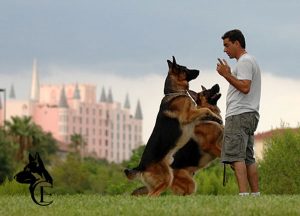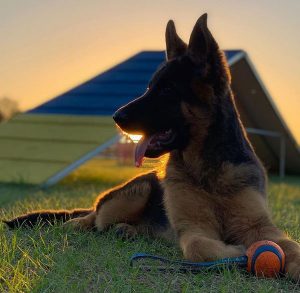Getting a new German Shepherd puppy is an exciting adventure for any new puppy owner. When bringing a new puppy into your home, you’re welcoming a new family member into your lives. German Shepherds make wonderful companions and can easily blend into your family environment. As we all know, when bringing a new puppy into the home, many questions and steps can be taken to make it as easy as possible. Canine Extreme has had 25+ years working with these fantastic dogs, and in this article, you can find some of the most common questions we receive when welcoming a new puppy into the home.
Understanding Training Drives in German Shepherds
 Working and training with your dog is a fun and exhilarating experience for both the dog and the trainer. The use of positive reinforcement for training is the go-to method for Canine Extreme. When training with positive reinforcement, it’s essential to know what “drives” are and how you can utilize them to aid in your dog’s training. The term “drive” can be generalized as an instinct that coaxes the dog into performing a specific behavior. A great example of this would be the use of a ball on a rope to gain the attention and excitement of a puppy. With an accurate understanding of a few critical drives, we can employ them to make positive reinforcement training a fun, practical, exciting, and overall enjoyable experience for both the dog and trainer.
Working and training with your dog is a fun and exhilarating experience for both the dog and the trainer. The use of positive reinforcement for training is the go-to method for Canine Extreme. When training with positive reinforcement, it’s essential to know what “drives” are and how you can utilize them to aid in your dog’s training. The term “drive” can be generalized as an instinct that coaxes the dog into performing a specific behavior. A great example of this would be the use of a ball on a rope to gain the attention and excitement of a puppy. With an accurate understanding of a few critical drives, we can employ them to make positive reinforcement training a fun, practical, exciting, and overall enjoyable experience for both the dog and trainer.
There are three main types of drives that we like to use in positive reinforcement training. These three drives are toy drive, food drive, and praise. While there is not one drive that is better than the other, they each have their perks. It’s essential to obtain a general understanding of each drive so that they can be explored to their maximum potential.
 The first type of drive we want to cover is toy drive. This type of drive can be best described as a “hunt” drive, as it’s the act of playing with a specific item. This does not have to be with a ball, but any item used for play. When properly making use of toy drive, timing is essential, and rewarding your dog at the opportune moment is the key. You will most commonly see dogs who have a higher toy drive in the world of sport, fast-paced obedience, protection, and high-level training. However, this can be used with any form of training, depending on your dog’s personality.
The first type of drive we want to cover is toy drive. This type of drive can be best described as a “hunt” drive, as it’s the act of playing with a specific item. This does not have to be with a ball, but any item used for play. When properly making use of toy drive, timing is essential, and rewarding your dog at the opportune moment is the key. You will most commonly see dogs who have a higher toy drive in the world of sport, fast-paced obedience, protection, and high-level training. However, this can be used with any form of training, depending on your dog’s personality.
 Food drive is the second type of drive used in positive reinforcement training. Just as it sounds, it’s a reward used in the form of food or treats. A key factor in this training method is that you do not need to withhold food from the dog, you can merely use a delicious treat that your dog enjoys. A dog with a high food drive can compete at high-level sport; however, food drive is commonly used for obedience and beginner training. It is a magnificent way to slowly direct your dog to a new behavior while maintaining precise control over the reward.
Food drive is the second type of drive used in positive reinforcement training. Just as it sounds, it’s a reward used in the form of food or treats. A key factor in this training method is that you do not need to withhold food from the dog, you can merely use a delicious treat that your dog enjoys. A dog with a high food drive can compete at high-level sport; however, food drive is commonly used for obedience and beginner training. It is a magnificent way to slowly direct your dog to a new behavior while maintaining precise control over the reward.
 The final drive that can be used is the act of praise. This is the simplest of the drives, and almost all dogs enjoy it. The use of praise is the most important reward and should be used in conjunction with the other two drives above. Toy and food drive can also be categorized as a form of praise as well. Examples of daily use are saying good when the dog sits at the door, petting the dog when they are lying down next to you, and praising your dog when they come back to you in the yard. Praise is the foundation of all training and can be used daily.
The final drive that can be used is the act of praise. This is the simplest of the drives, and almost all dogs enjoy it. The use of praise is the most important reward and should be used in conjunction with the other two drives above. Toy and food drive can also be categorized as a form of praise as well. Examples of daily use are saying good when the dog sits at the door, petting the dog when they are lying down next to you, and praising your dog when they come back to you in the yard. Praise is the foundation of all training and can be used daily.
All three types of drives are significant in understanding the most effective way to train, understand, and have fun with your dog. While all dogs will have some form of these three types of drives, they may come in differing levels. If loosely categorizing these drives into energy levels, it would be as follows: The higher the toy drive is, the more energy and workability the dog may have. A medium drive dog will have a nice even balance between all three. And a lower drive dog will display a low inclination to toy drive and food drive.
 Taking the time to understand the dog that you’re working with is the most indispensable factor when training with positive reinforcement. Every dog is different, and training a dog is not a race but a marathon that is supposed to be enjoyable for both parties. Taking your time to work, play, and interact with your dog will give you a better understanding of their drives and temperament. Once this is understood, you can use the drives that are right for the dog for the most benefit and enjoyment. Above all, having fun and spending time with your four-legged companion is the most important part!
Taking the time to understand the dog that you’re working with is the most indispensable factor when training with positive reinforcement. Every dog is different, and training a dog is not a race but a marathon that is supposed to be enjoyable for both parties. Taking your time to work, play, and interact with your dog will give you a better understanding of their drives and temperament. Once this is understood, you can use the drives that are right for the dog for the most benefit and enjoyment. Above all, having fun and spending time with your four-legged companion is the most important part!
More Articles
Different Types of German Shepherd Colors and Coats
German Shepherds are marvelous dogs who boast many features that appeal to our eyes. One of their main features are the colors and coat varieties that they can have. In this article, you will find a brief breakdown of some of the colors and coats of a German Shepherd.
Staying Cool In The Heat
Nothing says summer like sand between the paws, ice water by the pool, and walks in the sunshine. Summer is a time full of fun, adventures, and outdoor activities. While we all know how “cool” our dogs like to look over summer, like Kongo does while rocking his summer shades by the pool, it’s essential to remember to keep our dogs “cool” from the heat as well. Rest assured, while overheating and heatstroke are severe, with a bit of education and awareness of ways to keep cool, you and your pet can continue to enjoy all the fun activities that summer has to offer.